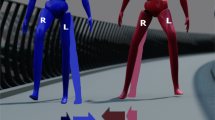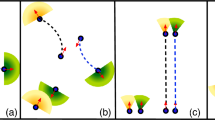Abstract
Interacting pedestrians in a crowd spontaneously adjust their footsteps and align their respective stepping phases. This self-organization phenomenon is known as synchronization. However, it is unclear why and how synchronization forms spontaneously under different density conditions, or what functional benefit synchronization offers for the collective motion of humans. Here, we conducted a single-file crowd motion experiment that directly tracked the alternating movement of both legs of interacting pedestrians. We show that synchronization is most likely to be triggered at the same density at which the flow rate of pedestrians reaches a maximum value. We demonstrate that synchronization is established in response to an insufficient safety distance between pedestrians, and that it enables pedestrians to realize efficient collective stepping motion without the occurrence of inter-person collisions. These findings provide insights into the collective motion behaviour of humans and may have implications for understanding pedestrian synchronization-induced wobbling, for example, of bridges.
This is a preview of subscription content, access via your institution
Access options
Access Nature and 54 other Nature Portfolio journals
Get Nature+, our best-value online-access subscription
$29.99 / 30 days
cancel any time
Subscribe to this journal
Receive 12 digital issues and online access to articles
$119.00 per year
only $9.92 per issue
Buy this article
- Purchase on Springer Link
- Instant access to full article PDF
Prices may be subject to local taxes which are calculated during checkout







Similar content being viewed by others
Data availability
The data necessary to support the findings of this manuscript are available in a public repository (https://zenodo.org/record/3732248).
Code availability
The custom code used is available in an online repository (https://github.com/mayifromcqhc/Crowd-synchronization).
References
Helbing, D., Farkas, I. J. & Vicsek, T. Simulating dynamical features of escape panic. Nature 407, 487–490 (2000).
Low, D. J. Statistical physics: following the crowd. Nature 407, 465–466 (2000).
Helbing, D. & Johansson, A. in Encyclopedia of Complexity and Systems Science (ed. Meyers, R. A.) 6476–6495 (Springer, 2009).
Schadschneider, A. et al. in Encyclopedia of Complexity and Systems Science (ed. Meyers, R. A.) 3142–3176 (Springer, 2009).
Timmermans, H. Pedestrian Behavior: Models, Data Collection and Applications (Emerald Group Publishing, 2009).
Helbing, D., Buzna, L. & Werner, J. T. Self-organized pedestrian crowd dynamics: experiments, simulations, and design solutions. Transport Sci. 39, 1–24 (2005).
Johansson, A. Constant-net-time headway as a key mechanism behind pedestrian flow dynamics. Phys. Rev. E 80, 026120 (2009).
Kuang, H., Li, X., Song, T. & Dai, S. Analysis of pedestrian dynamics in counter flow via an extended lattice gas model. Phys. Rev. E 78, 066117 (2008).
Hoogendoorn, S. P. & Daamen, W. Pedestrian behavior at bottlenecks. Transp. Sci. 39, 147–159 (2005).
Moussaid, M. et al. Traffic instabilities in self-organized pedestrian crowds. PLoS Comput. Biol. 8, e1002442 (2012).
Moussaid, M. et al. Experimental study of the behavioural mechanisms underlying self-organization in human crowds. Proc. R. Soc. B 276, 2755–2762 (2009).
Zhang, J. et al. Universal flow-density relation of single-file bicycle, pedestrian and car motion. Phys. Lett. A 378, 3274–3277 (2014).
Corbetta, A., Meeusen, J. A., Lee, C. M., Benzi, R. & Toschi, F. Physics-based modeling and data representation of pairwise interactions among pedestrians. Phys. Rev. E 98, 062310 (2018).
Rio, K., Bonneaud, S. & Warren, W. H. Speed coordination in pedestrian groups: linking individual locomotion with crowd behavior. J. Vis. 12, 190 (2012).
Rio, K. W. & Warren, W. H. A speed control law for pedestrian following based on visual angle. J. Vis. 11, 899 (2011).
Page, Z. & Warren, W. H. Visual control of speed in side-by-side walking. J. Vis. 12, 188 (2012).
Meerhoff, L. A., De Poel, H. J. & Button, C. How visual information influences coordination dynamics when following the leader. Neurosci. Lett. 582, 12–15 (2014).
Seyfried, A., Steffen, B., Klingsch, W. & Boltes, M.The fundamental diagram of pedestrian movement revisited. J. Stat. Mech. Theory Exp. 2005, P10002 (2005).
Dallard, P. et al. London Millennium Bridge: pedestrian-induced lateral vibration. J. Bridge Eng. 6, 412–417 (2001).
Strogatz, S. H., Abrams, D. M., McRobie, A., Eckhardt, B. & Ott, E. Theoretical mechanics: crowd synchrony on the Millennium Bridge. Nature 438, 43–44 (2005).
Eckhardt, B., Ott, E., Strogatz, S. H., Abrams, D. M. & McRobie, A. Modeling walker synchronization on the millennium bridge. Phys. Rev. E 75, 021110 (2007).
Abdulrehem, M. M. & Ott, E. Low dimensional description of pedestrian-induced oscillation of the millennium bridge. Chaos 19, 013129 (2009).
Belykh, I., Jeter, R. & Belykh, V. Foot force models of crowd dynamics on a wobbly bridge. Sci. Adv. 3, e1701512 (2017).
Patel, A. D., Iversen, J. R., Bregman, M. R. & Schulz, I. Experimental evidence for synchronization to a musical beat in a nonhuman animal. Curr. Biol. 19, 827–830 (2009).
Bode, N. W., Faria, J. J., Franks, D. W., Krause, J. & Wood, A. J. How perceived threat increases synchronization in collectively moving animal groups. Proc. R. Soc. B 277, 3065–3070 (2010).
Couzin, I. D. Synchronization: the key to effective communication in animal collectives. Trends Cogn. Sci. 22, 844–846 (2018).
Ashraf, I., Godoy-Diana, R., Halloy, J., Collignon, B. & Thiria, B. Synchronization and collective swimming patterns in fish (Hemigrammus bleheri). J. R. Soc. Interface 13, 20160734 (2016).
Gao, J., Havlin, S., Xu, X. & Stanley, H. E. Angle restriction enhances synchronization of self-propelled objects. Phys. Rev. E 84, 046115 (2011).
Liu, Z. & Guo, L. Synchronization of multi-agent systems without connectivity assumptions. Automatica 45, 2744–2753 (2009).
Wang, L. & Chen, G. Synchronization of multi-agent systems with metric–topological interactions. Chaos 26, 094809 (2016).
Chattaraj, U., Seyfried, A. & Chakroborty, P. Comparison of pedestrian fundamental diagram across cultures. Adv. Complex Syst. 12, 393–405 (2009).
Jelić, A., Appert-Rolland, C., Lemercier, S. & Pettré, J. Properties of pedestrians walking in line: fundamental diagrams. Phys. Rev. E 85, 036111 (2012).
Jelić, A., Appert-Rolland, C., Lemercier, S. & Pettré, J. Properties of pedestrians walking in line. II. Stepping behavior. Phys. Rev. E 86, 046111 (2012).
Fang, Z. M. et al. A continuous distance model (CDM) for the single-file pedestrian movement considering step frequency and length. Phys. A 391, 307–316 (2012).
Cao, S. et al. Pedestrian dynamics in single-file movement of crowd with different age compositions. Phys. Rev. E 94, 012312 (2016).
Cao, S., Zhang, J., Song, W., Shi, C. A. & Zhang, R.The stepping behavior analysis of pedestrians from different age groups via a single-file experiment. J. Stat. Mech. Theory Exp. 2018, 033402 (2018).
Zeng, G. et al. Experimental study on the effect of background music on pedestrian movement at high density. Phys. Lett. A 383, 1011–1018 (2019).
Zeng, G., Cao, S., Liu, C. & Song, W. Experimental and modeling study on relation of pedestrian step length and frequency under different headways. Phys. A 500, 237–248 (2018).
Wang, J. et al. Step styles of pedestrians at different densities. J. Stat. Mech. Theory Exp. 2018, 023406 (2018).
Wang, J. et al. Linking pedestrian flow characteristics with stepping locomotion. Phys. A 500, 106–120 (2018).
Yanagisawa, D., Tomoeda, A. & Nishinari, K. Improvement of pedestrian flow by slow rhythm. Phys. Rev. E 85, 016111 (2012).
Ma, Y., Sun, Y. Y., Lee, E. W. M. & Yuen, R. K. K. Pedestrian stepping dynamics in single-file movement. Phys. Rev. E 98, 062311 (2018).
Zhao, Y. & Zhang, H. M. A unified follow-the-leader model for vehicle, bicycle and pedestrian traffic. Transp. Res. B 105, 315–327 (2017).
Seitz, M. J. & Köster, G. Natural discretization of pedestrian movement in continuous space. Phys. Rev. E 86, 046108 (2012).
Seitz, M. J., Dietrich, F. & Köster, G. The effect of stepping on pedestrian trajectories. Phys. A 421, 594–604 (2015).
Pimentel, R. L., Araújo, M. C. Jr, Braga Fernandes Brito, H. M. & Vital de Brito, J. L. Synchronization among pedestrians in footbridges due to crowd density. J. Bridge Eng. 18, 400–408 (2013).
Gazzola, F. & Racic, V. A model of synchronisation in crowd dynamics. Appl. Math. Model. 59, 305–318 (2018).
Joshi, V. & Srinivasan, M. Walking crowds on a shaky surface: stable walkers discover Millennium Bridge oscillations with and without pedestrian synchrony. Biol. Lett. 14, 20180564 (2018).
Chambers, C., Kong, G., Wei, K. & Kording, K. Pose estimates from online videos show that side-by-side walkers synchronize movement under naturalistic conditions. PLoS ONE 14, e0217861 (2019).
Ren, X., Zhang, J. & Song, W.Contrastive study on the single-file pedestrian movement of the elderly and other age groups. J. Stat. Mech. Theory Exp. 2019, 093402 (2019).
Eilhardt, C. & Schadschneider, A. Stochastic headway dependent velocity model for 1D pedestrian dynamics at high densities. Transp. Res. Proc. 2, 400–405 (2014).
Ziemer, V., Seyfried, A. & Schadschneider, A. in Traffic and Granular Flow ‘15 (eds. Knoop, V. L., & Daamen, W.) 89–96 (Springer, 2016).
Zhang, J., Klingsch, W., Schadschneider, A. & Seyfried, A.Ordering in bidirectional pedestrian flows and its influence on the fundamental diagram. J. Stat. Mech. Theory Exp. 2012, P02002 (2012).
Zhang, J., Klingsch, W., Schadschneider, A. & Seyfried, A.Transitions in pedestrian fundamental diagrams of straight corridors and T-junctions. J. Stat. Mech. Theory Exp. 2011, P06004 (2011).
Vanumu, L. D., Rao, K. R. & Tiwari, G. Fundamental diagrams of pedestrian flow characteristics: a review. Eur. Transp. Res. Rev. 9, 49 (2017).
Liu, X., Song, W. & Zhang, J. Extraction and quantitative analysis of microscopic evacuation characteristics based on digital image processing. Phys. A 388, 2717–2726 (2009).
Ma, J., Song, W. G., Fang, Z. M., Lo, S. M. & Liao, G. X. Experimental study on microscopic moving characteristics of pedestrians in built corridor based on digital image processing. Build. Environ. 45, 2160–2169 (2010).
Chattaraj, U., Seyfried, A., Chakroborty, P. & Biswal, M. K. Modelling single file pedestrian motion across cultures. Proc. Soc. Behav. Sci. 104, 698–707 (2013).
Helbing, D., Johansson, A. & Al-Abideen, H. Z. Dynamics of crowd disasters: an empirical study. Phys. Rev. E 75, 046109 (2007).
Acknowledgements
The authors acknowledge that this research was supported by the National Natural Science Foundation of China (grant number 71901156), Strategic Priority Research Program of the Chinese Academy of Sciences (grant number XDA23090502) and Fundamental Research Funds for the Central Universities. The funders had no role in study design, data collection and analysis, decision to publish or preparation of the manuscript.
Author information
Authors and Affiliations
Contributions
Y.M. designed the experiments, analysed the results and wrote and revised the manuscript. E.W.M.L., M.S. and R.K.K.Y. gave advice about the experimental design and data interpretation, and assisted in revising the manuscript.
Corresponding author
Ethics declarations
Competing interests
The authors declare no competing interests.
Additional information
Peer review information Primary handling editor: Jamie Horder.
Publisher’s note Springer Nature remains neutral with regard to jurisdictional claims in published maps and institutional affiliations.
Supplementary information
Supplementary Information
Supplementary Fig. 1: Schematic of the conducted single-file crowd motion experiments under seven global densities with 10, 20, 30, 40, 50, 60 and 70 participants, where, N represents the number of experimental participants.
Rights and permissions
About this article
Cite this article
Ma, Y., Lee, E.W.M., Shi, M. et al. Spontaneous synchronization of motion in pedestrian crowds of different densities. Nat Hum Behav 5, 447–457 (2021). https://doi.org/10.1038/s41562-020-00997-3
Received:
Accepted:
Published:
Issue Date:
DOI: https://doi.org/10.1038/s41562-020-00997-3
This article is cited by
-
Modelling physical contacts to evaluate the individual risk in a dense crowd
Scientific Reports (2023)
-
Spontaneous gait phase synchronization of human to a wheeled mobile robot with replicating gait-induced upper body oscillating motion
Scientific Reports (2022)
-
Analysis and Modeling of Pedestrian Flow in a Confined Corridor Focusing on the Headway Distance and Velocity of Pedestrians
Fire Technology (2022)
-
Emergence of the London Millennium Bridge instability without synchronisation
Nature Communications (2021)



